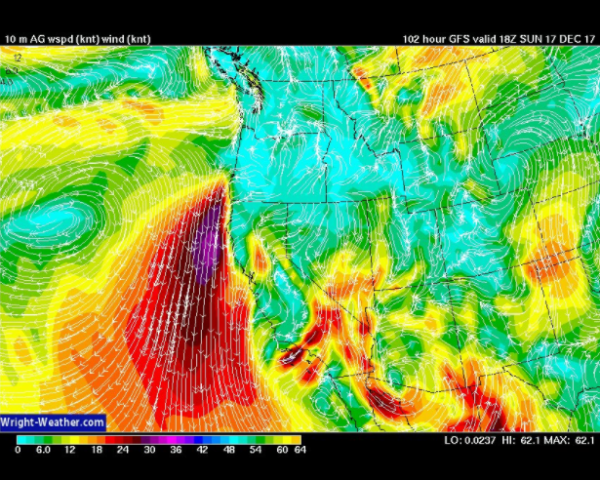Worsening Weather to Feed Monstrous Thomas Fire Through Sunday
14
December, 2017
It
shouldn’t be happening in typically wetter, cooler December. But,
due to human-forced climate change, it is.
The
Thomas Fire, at 242,000 acres, is
now the fourth largest fire in California history.
Alone, it has destroyed 900 structures — a decent town’s worth
gone up in smoke. And today it threatens pretty much all of Santa
Barbara’s 62,000 buildings. For future days promise
conditions that could expand the monstrous blaze into the largest
fire ever seen for the state.
Dec 14 U.S. & Global Climate and Weather Report 1. High amplitude Jet Stream pattern continues for U.S. 2. Western ridge enhancing heat, drought, fire hazard. 3. Eastern trough bringing in Arctic air. 4. U.S. temps 0.37 C above average. 5. Global temps 0.6 C above average.
(Persistent
western ridge formation is an expected upshot of sea ice retreat in
the Arctic. A feature that will result in a drier, warmer, more fire
prone California if the trend toward sea ice melt and global warming
continues.)
Firefighters
battling the blaze have faced insane odds to manage a herculean feat
— achieving 35 percent containment as blowtorch like Santa Ana
winds consistently billowed through the region over the past two
weeks. These
winds have been both abnormally strong and persistent.
And they’re run over dry lands through a season that is typically
known for its more prevalent rainfall — not
the expanding drought we see today.
Given
these presently very abnormal conditions, fire officials don’t
expect to achieve full 100 percent containment for three more weeks.
And that’s
with over 8,144 firefighters on the ground assisted by 1,004 fire
engines and 27 helicopters.
It's been more than 250 days since it rained in Southern California.
The combination of extremely dry conditions, warm temps, strong winds, and lack of rain has produced an unprecedented potential for rapid fire growth in the middle of the rainy season.
(The
2012 to 2017 California drought was slaked by rains last winter.
However, it appears to have returned in force with southern portions
of the state again facing an extended dry period.)
Present
weather conditions for California are extraordinary. A persistent
ridge of high pressure has hovered over the region. And this high has
helped to spike local temperatures, speed a re-emergence of drought,
and drive very powerful Santa Ana winds through the region. The high
formed as sea ice advance in the Chukchi and Bering Seas far to the
north lagged. Open water that is usually ice covered at this time of
year radiated more heat into the local atmosphere — providing a
slot of warmer air that assisted this drought, heat, and
wind-promoting high pressure ridge in forming.
The
intensity of these highs, influenced by climate change, out west has
consistently risen into the 1040+ hPa range. Highs that have been
juxtapposed by a strong low further south near Mexico. And a steep
pressure gradient between these two persistent weather systems has
helped to drive the very strong, fire-fanning, Santa Ana winds
through the region. As the Thomas Fire blossomed last week, fire
conditions achieved extremes never before seen in state history as
those hot, dry winds roared over hills and through valleys.
(GFS
model runs show the fire fanning Santa Ana winds strengthening
through Sunday. Hat tip to Dan
Leonard.)
Unfortunately,
weather models for the next few days show this Santa Ana wind
producing pressure gradient either persisting or strengthening.
Today, this
gradient is producing winds with gusts of up to 55 mph.
By Sunday, the high over the Pacific is predicted to face off against
a low over Northwestern Mexico. And the gradient between these two
systems may further intensify these fire fanning winds. Wind speed
and fire hazard are not expected to be as extreme as last week. But
the re-intensifying winds will do firefighters no favors.
In
addition, and perhaps more importantly to the long range
picture, there
is not even a hint of rain in the forecast through at least the next
week.
Dry, warmer than normal weather is expected to remain in place at
least through that period. And hope for wetter, cooler weather has
only begun to emerge in the longer range, less certain forecast.





No comments:
Post a Comment
Note: only a member of this blog may post a comment.